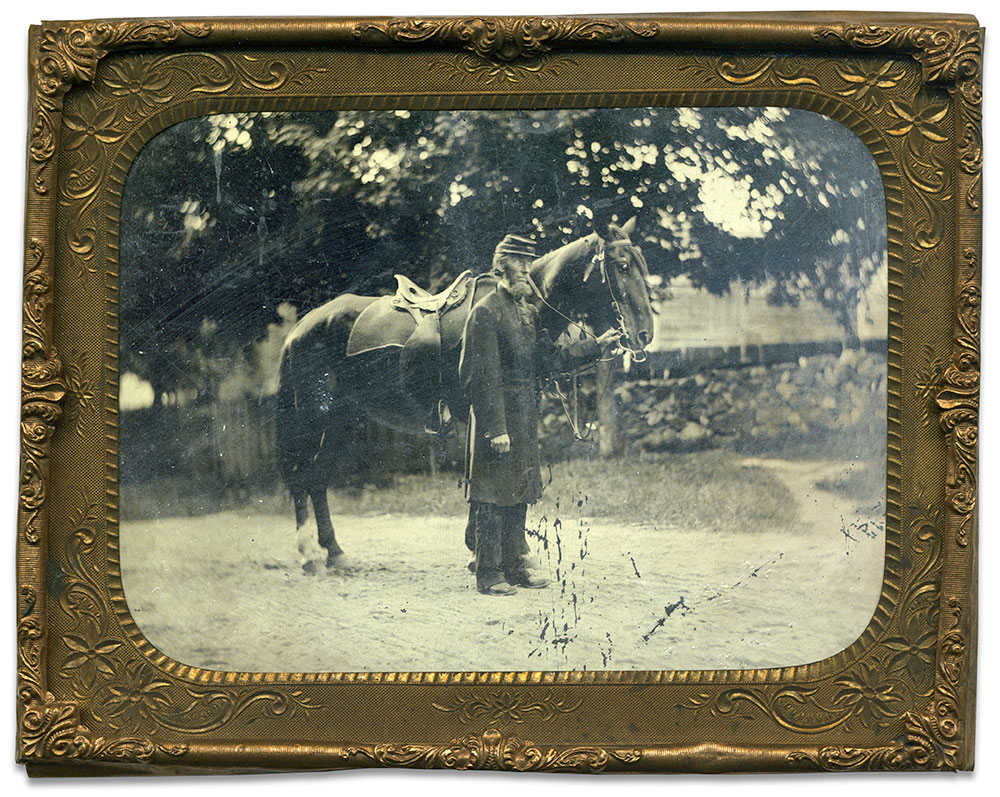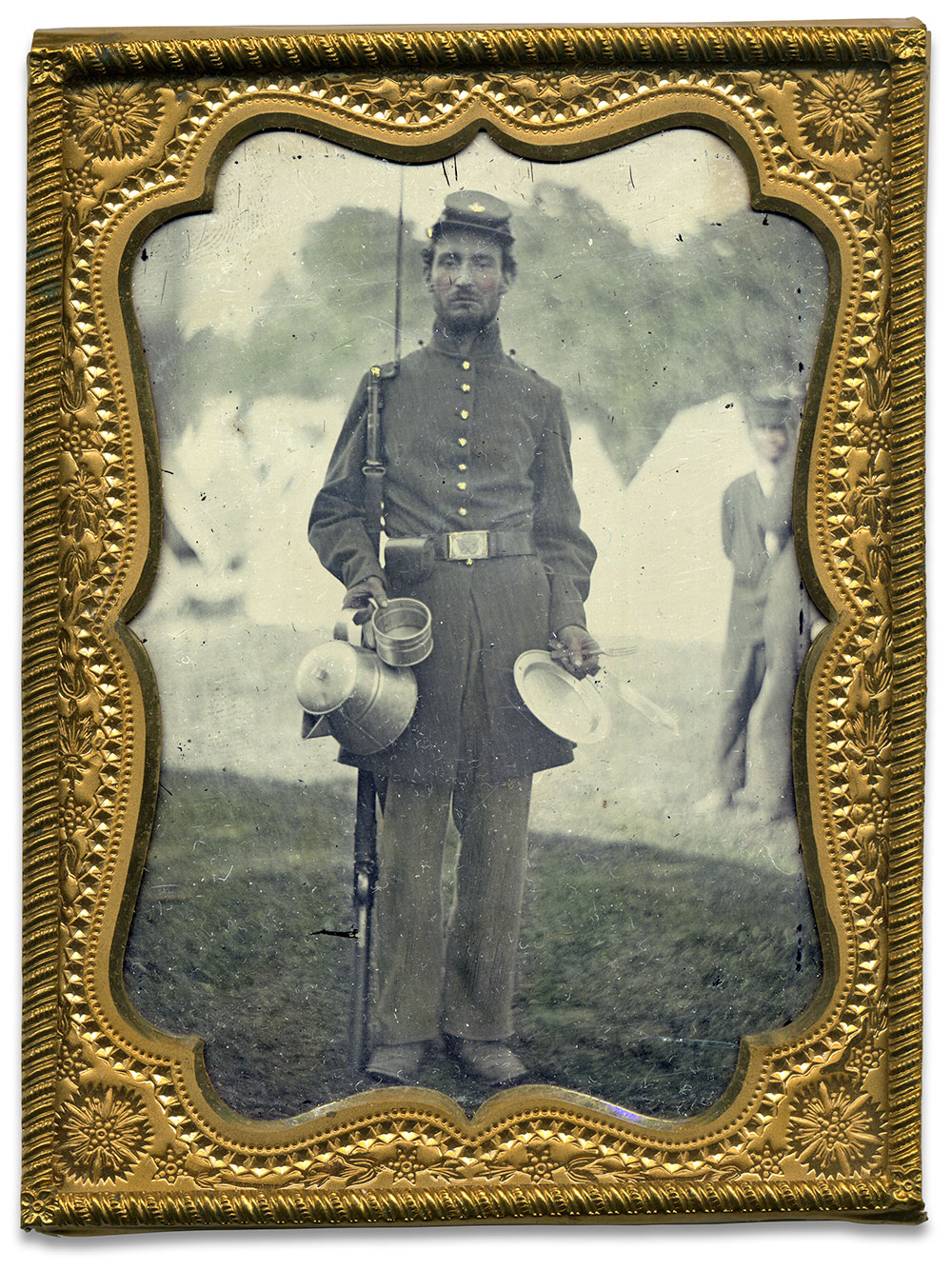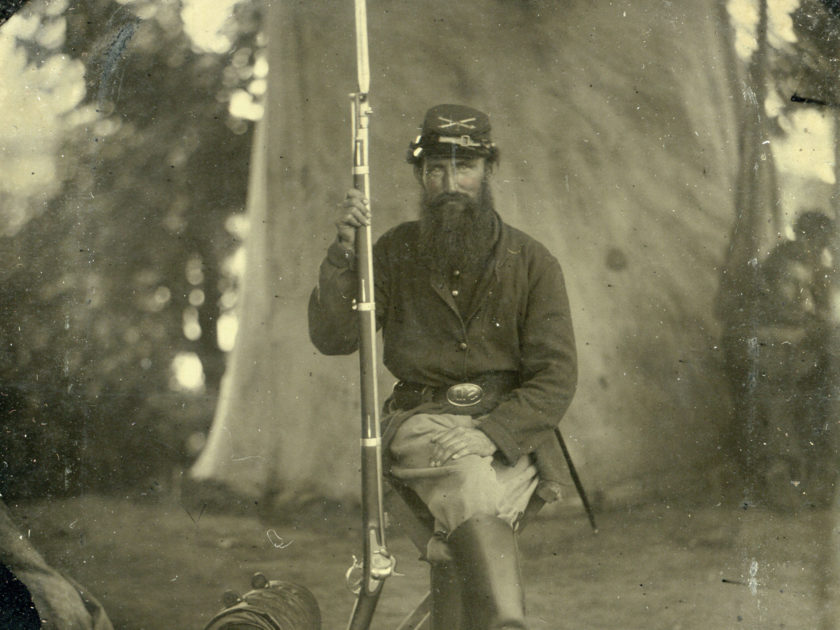Images of soldiers pictured in camp, on campaign and other locations have always held a special interest for C. Paul Loane.
“There is more going on than just the soldiers standing there,” Loane explains. “They are particularly helpful in seeing just what kind of environment the soldiers were in or what gear they really did use.”
Loane speaks from experience. After more than 50 years as a collector, he has seen countless photographs. “I was a child of the 50s and had the usual youthful interest in soldiers and guns. I think I was hardwired to like history and antiques from birth,” he notes. During his youth, he also learned that his great-grandfather had served in the Civil War, which really piqued his interest. Later, he discovered he had no fewer than five ancestors who fought for the Union.
Guns and headgear were Loane’s initial focus as a collector. During these formative years, which coincided with the centennial of the war, he could purchase a musket for $50 and an original forage cap for $25. A dearth of information about uniforms and headwear at this time, however, led him to examine photographs.
“Aside from Francis Lord’s groundbreaking Civil War Collector’s Encyclopedia there was little that told me about those things, so I began searching for original images that I could study,” Loane remembers. “Soon I began to appreciate being able to see an actual participant in the war and finding the history behind the image.”
Loane eventually focused his collection on uniforms and images. The portraits continue to be a source of fascination for him. He observes, “I smile when I can see something in my collection looking back at me in an image. It’s a great source of confirmation and a special way of connecting to the past.”
Representative images from the Loane collection salute the great images taken outdoors.

EQUIPPED AND READY TO MARCH, a bearded member of an unknown heavy artillery regiment displays his Model 1855 rifle musket, with his knapsack packed beside him. To the right of the tent in the background, a soldier sits with arms folded over his knees. Just visible behind him is another individual. Both men may have been waiting in line for their turn to have their likenesses made.

ROBERT SHAW took a break from the monotony of winter quarters at Stafford Heights, Va., in September 1862 to pose for a pair of portraits. A private in Company F of the 145th New York Infantry, 33-year-old Shaw is clad in his government issued kersey overcoat. In one portrait, left, he stands with his Enfield rifle musket at “parade rest” in front of a simple canvas backdrop tacked to the side of a whitewashed clapboard building. In the second photograph, Shaw strikes a more warlike pose as he kneels with his Enfield, cocked and ready, its distinctive nipple protector hanging from a chain fixed to the trigger guard. Shaw’s regiment was assigned to the 12th Corps, and participated in the battles at Chancellorsville and Gettysburg. In the latter engagement, it was active in the fighting at Culp’s Hill. Shaw was later hospitalized in Philadelphia, Pa., and received a discharge for disability in December, just a few days after his regiment disbanded.

TWO FEDERALS demonstrate positions of the bayonet drill introduced in 1852 by then-captain George B. McClellan, who would famously serve the Union a decade later as the controversial commander of the Army of the Potomac. The enlisted man in the foreground prepares to lunge while the first lieutenant performs parry in quarte. A period notation affixed to the back of the image is a critique: “Correct except the one thrusting, should have his hind foot flat on the ground and at right angles to the front foot, only bending ankle. In the photograph, it is slightly raised, and not exactly at right angle to the front feet.” A more recent notation suggests both are members of the 69th New York Infantry.

AN UNIDENTIFIED TROOPER sits astride his horse on a soggy field, pointing his pistol at the camera in this crisp portrait. Affixed to the front of his forage cap are brass characters that indicate his service in Company D of the 2nd Cavalry. His state affiliation is not known.

DRESSED IN THE PLAIN UNIFORM OF A CHAPLAIN, Winthrop Phelps of the 2nd Connecticut Heavy Artillery stands beside his horse, “Old Ned.” Organized in the summer of 1862, the 2nd was one of the regiments of “Heavies” that occupied the defenses of Washington until reassigned to the Army of the Potomac in the spring of 1864 to participate in operations against Gen. Robert E. Lee and his Army of Northern Virginia. The 2nd was deployed as infantry and found itself in the thick of the action during the Battle of Cold Harbor. Untested in combat, the men and officers charged Confederate works and suffered 323 killed and wounded. Chaplain Phelps, 46, later wrote to his wife, Lucy, “Throughout the battle, the shells flew all about to my terror. You cannot conceive the horror and awfulness of a battle. I never wish to hear another, much less see it.” Phelps and his comrades would see much more fighting at little-known places that would become household names, including Hatcher’s Run and Sailor’s Creek. Phelps survived the war and mustered out with the 2nd on Aug. 18, 1865. An almost identical portrait resides in Connecticut, in the collection of the Litchfield Historical Society.

DURING THE BATTLE OF CHICKAMAUGA in September 1863, a hard-fighting force of mounted infantry known as Wilder’s Lightning Brigade held off Confederate attackers long enough to enable the fragmented Union Army of the Cumberland to regroup. The brigade, commanded by Col. John T. Wilder, included the 72nd Indiana Infantry. One of its enlisted men, Pvt. John W. Munson of Company F, is pictured in perhaps the only known photograph of a member of the brigade taken in the field. Munson grasps his Spencer Repeating Rifle and sits astride his horse, named with tongue-in-cheek “Col. John Mosby.” A native of Attica, Ind., Munson served in the 72nd from July 1862 to July 1865.

A GROUP OF STALWARTS gather before a tent and take to the trees for this portrait of nonchalance in camp. The brass on the front of two of the forage caps identifies them as members of the 8th Massachusetts Volunteer Militia. The unit was called into service three times. First, as part of the “Minute Men” answering the call in April 1861 for three months service; the second time for nine months in November 1862, when it served in the Department of North Carolina; and the final time, in July 1864, for 100 days, performing guard duties in and around Baltimore. Despite the multiple calls to arms, the unit had no personnel killed or mortally wounded during the war.

OFFICERS ON THE STAFF OF MAJ. GEN. GEORGE G. MEADE pause from their regular duties to pose for their group portrait. The general’s son, George, Jr. (1843-1897), sits in profile on the ground with his pipe. Directly to his left, seated cross-legged, you see Capt. Addison Gordon Mason (1839-1894). At the far left is Capt. John Coalter Bates (1842-1919), who remained in the army after the war, and retired as a lieutenant general in 1906. Next to him, on stools or a bench, from left to right, are: Maj. William Riddle (died 1867), a member of the 34th Pennsylvania Infantry captured during the Battle of Mechanicsville, Va., on June 27, 1862, and later escaped from Libby Prison; Maj. James Cornell Biddle (1835-1908), who had served in the 17th and 27th Pennsylvania infantries prior to joining the staff; Capt. Francis Markoe Bache (1833-1867), who served in the regular army; and Lt. Col. Theodore Lyman (1833-1897), whose often-cited wartime letters and notebooks offer keen insights into the Army of the Potomac during the latter stages of the war. Standing in the back is Lt. Frederick Rosencrans, a Swedish volunteer aide, playfully holding a slouch hat over Maj. Biddle, and the highly-respected Capt. Charles Evert Cadwalader (1839-1907), a cavalryman who served on the staff of Maj. Gen. Joseph Hooker during his time as commander of the Army of the Potomac.

Many of the officers wear the distinctive Army of the Potomac Staff badge adopted in May 1863. The badge is a circular silver wreath that surrounds a gold spread-winged eagle on a solferino (pinkish purple) background.
This portrait is similar to another image in the collection of the Library of Congress of the staff taken by Timothy O’Sullivan in April 1864 at Brandy Station, Va. (Detail, left.)

ARMED AND READY FOR FOOD, this soldier pauses for his photograph with a bayonet fixed on his rifle musket and a handful of tin-ware and utensils, including the essential coffee pot. Perhaps coming off evening parade, he wears a frock coat sans shoulder scales. The rectangular Model 1851 belt plate suggests he is a non-commissioned officer.

FIVE BUDDIES SIT ON THE GROUND for a classic messmates image. The structures in the background suggest that a permanent camp may be close by, as does the fact these simply dressed Union veterans appear to be enjoying fresh baked bread in place of the ubiquitous hardtack. Now, pass the coffee pot!

WITH LITTLE TO DO ON A HOT SUMMER DAY, a group of kibitzers have gathered around to gossip, and perhaps see what the photographer in camp was up to. Evidence suggests that these Union troops are no longer merely recruits, but masters of living life in the field. To promote airflow beneath their tent, the men have cut sticks to raise their shelter halves, using the poles to hang haversacks and other equipment. At the left, a tin coffee pot sits by a shovel thrust in the ground. An assortment of mess gear lies alongside. The soldier seated on the left plays cards with the comrade opposite him, and shows us his 10 of spades, while another friend observes, enjoying a smoke from the small pipe in his hand. A stack of Colt 1855 Military Revolving Rifles stands beside them, draped with leather gear. The soldier seated on the right cleans his rifle, with the five-shot cylinder resting on his foot.
The Colt’s Rifle was, along with the Henry and Spencer repeaters, one of several attempts to develop a weapon with increased firepower. Unlike the competition, which used a self-contained metallic cartridge, Colt’s gun was still a slow loading cap-and-ball affair, and had a major drawback: When firing the weapon, hot gas leaking from the gap between the cylinder and the barrel might ignite all of the chambers at once. This “chain fire” would send a spray of metal forward into the left arm and hand of the user, possibly inflicting severe injury. Naturally, many soldiers distrusted them. About 9,300 were made between 1856 and 1864, though the government purchased less than 5,000. These were issued primarily to units in the Midwest, from where this image emerged.

“PUTTING UP THE GALLEY/UNCLE ELLICK ON TOP” is written inside the case that houses this image. Pictured are hard working soldiers constructing a cook hut, most likely for a winter encampment, while two of their comrades, seated, offer encouragement. The man on top, who appears to wear a cavalry shell jacket, might possibly be Belle Ellick, a cook for the 3rd Tennessee Cavalry.

WITH THE TENNESSEE RIVER snaking nearly 2,000 feet below him, a Union drummer sits for his portrait on Lookout Mountain’s impressive, and somewhat dangerous, Point Lookout. He was one of thousands of soldiers to do so during the war. The image was probably made by entrepreneurial photographer Robert N. Linn, who set up a photo studio with his brother, Birney, on this key position within a month following the engagement on Nov. 24, 1863, which came to be known as the “Battle Above the Clouds.” The Linn brothers operated a lucrative business into the 1880s. While we know nothing personal about the drummer, clad in a simple sack coat and an oilcloth cover on his forage cap to keep the dust at bay, the drum is more distinctive. The ropes are fastened to the rims by gray metal clips (not by holes drilled through the rims themselves). The leather “ears” are decorated with small metal heraldic shields. These features indicate the instrument was most likely made by craftsman William Shute Tompkins of Yonkers, N.Y. Surviving drums by this maker show they were state-of-the-art, and usually found with elaborate inlays and custom painted decoration.
SPREAD THE WORD: We encourage you to share this story on social media and elsewhere to educate and raise awareness. If you wish to use any image on this page for another purpose, please request permission.
LEARN MORE about Military Images, America’s only magazine dedicated to showcasing, interpreting and preserving Civil War portrait photography.
VISIT OUR STORE to subscribe, renew a subscription, and more.

